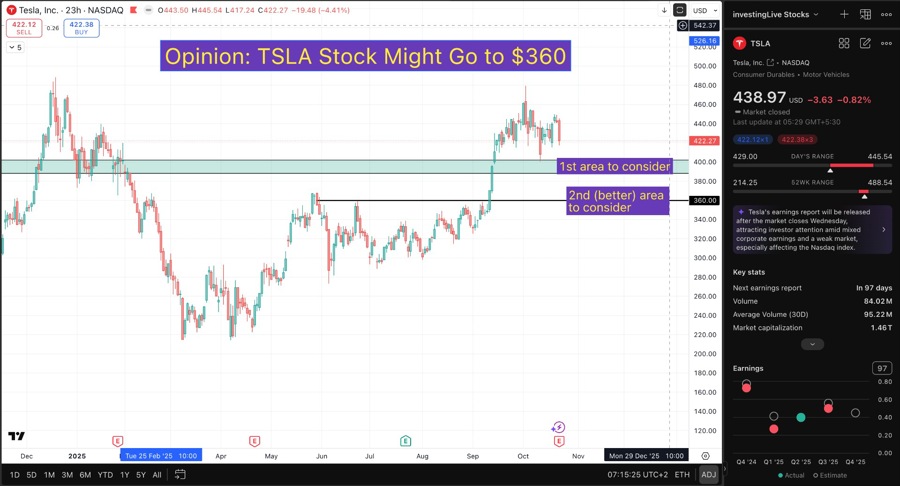
Tesla Stock Analysis After Earnings – Key Levels and Dip Buying Zones
Tesla’s latest earnings report sparked a negative reaction from traders, and the market’s message is clear: sentiment remains cautious. The company reported a 37% drop in profits after cutting vehicle prices, and while Elon Musk used the tail end of the call to push his ambitious robotaxi vision and a $1 trillion pay package proposal, that discussion may have further dampened investor confidence.
Tesla also faces a more crowded and competitive EV landscape than in its years of dominance. Combine that with a cooling NASDAQ and weak post-earnings reactions in names like Netflix, and it’s understandable that traders are seeking lower prices for Tesla in the short term.
Short-Term Key Levels
From a technical standpoint, the $437–$447 range remains the immediate resistance band. For the bullish side to gain traction, price would need to regain and sustain above this zone, opening the path toward $445–$447 and beyond.
However, the more realistic near-term focus lies below, particularly around $419 (the October 14 value area low) and $412 (close to the October 10 value area low). Those are logical interim levels for traders watching for signs of stabilization or exits.
The $400 Zone – A Price Magnet
The most important area to watch is the $400 round number and its surrounding range between $388 and $403.
This cluster includes key levels from the volume profile and has the potential to act as a price magnet zone—a place where price is naturally drawn as traders reposition or unwind.
If Tesla declines toward this zone, it’s not a signal to buy blindly, but a region to observe closely. Watch how price behaves and whether buyers start showing conviction before considering a dip buy.
The More Strategic Dip: $359–$367 Range
The deeper and more interesting opportunity for dip buyers may only come if Tesla drops into the $359–$367 range.
In my view, the ideal scenario would involve a temporary breakdown below $360, followed by a reclaim back above it—suggesting exhaustion of sellers and the start of potential base-building.
If that happens, the technical setup would align better with a higher-probability dip-buying scenario, offering traders a cleaner risk-reward structure.
At that point, Tesla would also be trading roughly 26% below its all-time high, a correction magnitude often viewed as healthy enough for long-term investors to reassess entries.
Risk and Portfolio Management
For existing Tesla holders, diluting or trimming part of the position may make sense at current levels, especially given the post-earnings weakness and uncertain sentiment around leadership priorities.
If price fails to sustain above the bullish threshold (around the upper 430s–440s), reducing exposure now and waiting for more favorable levels—such as the $400 or even $360 zones—could be a logical way to mitigate risk.
Remember, it’s always possible to rebuy later, and managing risk is just as important as finding the perfect entry.
Remember, Tesla Stock Holders, Buyers and Sellers:
These observations are not financial advice from investingLive.com (we never do that) but my personal opinion based on key levels and market structure. Traders and investors should monitor how price reacts near the $400 and $360 zones, as those areas could define Tesla’s next chapter in the months ahead.




